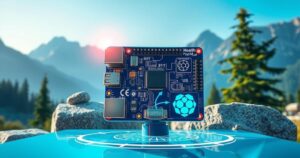NASA Goddard’s AI Strategy: A Roadmap to Future Solutions
- NASA Goddard is launching a generative AI chatbot for its workforce.
- The chatbot enables non-technical employees to interact with vast data.
- NASA intends to create a text to spaceship system enhancing design efficiency.
- Early AI pilots struggled with infrastructure, but now strides are being made.
- The AI Policy Lab brings experts together to find solutions to current challenges.
NASA Goddard’s Bold AI Vision Takes New Shape
NASA Goddard Space Flight Center is upping its game in the world of artificial intelligence. With generative AI taking center stage, the agency isn’t just limiting itself to scientific applications anymore. Omar Hatamleh, the chief AI officer at Goddard, recently described an ambitious plan to roll out an internal chatbot that will allow employees to tap into the agency’s vast data resources. “Now, people with no technical knowledge can leverage the potential and the capacity of artificial intelligence,” Hatamleh shared during a recent AI event, suggesting that the evolution of AI use cases at Goddard could soon be explosive. We’re talking about transcending the typical realms of science and engineering to touch every facet within the agency. The push for real-world applications is gaining traction, and it’s not just about implementing the technology blindly. Hatamleh was joined by prominent figures from universities, tech giants, and industry leaders who explored the various paths organizations can take to make AI a core component of their operations. Employees are already taking the chatbot for a spin, uploading documents and engaging in interactive exchanges that go beyond traditional search engine queries. Hatamleh emphasized that this is not a simple Q&A tool; it’s more like a conversation that gets better with time and input. Expect a second iteration that connects this chatbot to vast databases for even more robust functionality—this could redefine how they work across all departments.
Innovative Concepts are Transforming AI Applications
The future looks bright for AI at Goddard, and Hatamleh introduced some innovative concepts that are worth noting. They have a product dubbed “text to structures” that allows scientists to leverage AI for creating more efficient designs. Imagine being able to produce something lighter and more effective than ever before— this is no minor upgrade; it’s a real game changer. Looking ahead, Goddard is venturing into a next-gen initiative called “text to spaceship,” designed to connect several AI tools into a singular, autonomous system. Hatamleh pointed out that it could pave the way for unprecedented designs, enhancing collaboration and streamlining workflows. This interconnected approach isn’t just about efficiency, it’s about rethinking how traditional tasks are accomplished. Employees in procurement or finance often find themselves bogged down by repetitive tasks. Working to minimize these bottlenecks isn’t just a dream; it’s an actionable strategy that the organization is already pursuing. Hatamleh’s team is committed to using AI not merely as a technological upgrade but as a transformative force, pushing to alleviate mundane work so teams can indeed focus on complex challenges. Meanwhile, Kurt Steege from ThunderCat Technology noted that early AI trials faced several challenges including inadequate infrastructure and slowness—lessons learned that are valuable for amplifying future efforts.
Collaboration is Key to AI Success
In tandem, there’s a broader conversation taking place about the long-term success of AI within organizations. CTO Christopher “CT” Thomas from Dell Technologies weighed in on how vital it is for public agencies to engage in structured discussions surrounding system architectures and governance with industry partners. He underlined the significance of being meticulous with planning; sketching out what success looks like is integral to achieving real impact. Measures of success often hinge on whether organizations are able to effectively communicate what they hope to accomplish and the expected ROI. Yet, questions still linger over proper alignment of goals. Michelle De Mooy from Georgetown University’s AI Policy Lab highlighted that assembling the right team can make all the difference. When experts from varied backgrounds convene, the possibilities for innovative breakthroughs rise. Her lab’s focus isn’t merely on recommendations but devising tangible solutions to existing challenges, like election security. They’ve even produced public service announcements addressing crucial issues surrounding technology and governance. Dealing with the implications of deep fake technology was one of their initiatives—a timely concern as we approach critical upcoming elections.
The strides being taken in AI, particularly at NASA Goddard, are pioneering exciting new pathways for future innovation. With a focus on usage across various sectors beyond just science, the potential for transformation is immense. Collaboration among government, academia, and industry will be crucial for maximizing the effectiveness and return on investment from these AI technologies. As experts gather to share insights and align goals, the future of AI in government looks poised for impactful developments.




